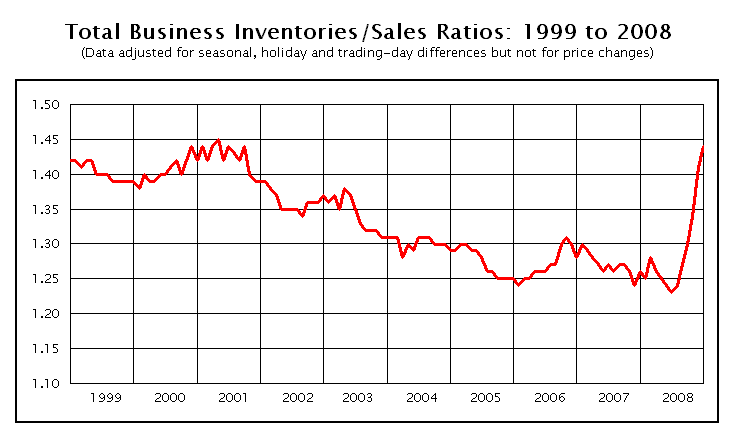다음은 US Business Inventories/Sales Ratio : 2000~2009, 미국 기업재고/매출 비율 입니다. (2009년 3월 12일 발표, 현지)


FOR IMMEDIATE RELEASE
THURSDAY, MARCH 12, 2009, AT 10:00 A.M. EDT
Timothy Winters (Retail): (301) 763-2713 CB09-35
John Miller (Wholesale): (301) 763-2703
Chris Savage (Manufacturing): (301) 763-4832
MANUFACTURING AND TRADE INVENTORIES AND SALES
January 2009
|
INTENTION TO REVISE: Revisions to the Wholesale and Retail adjusted and not adjusted monthly estimates for sales and inventories are scheduled for release in March 2009 and April 2009, respectively. Estimates will be revised to reflect the results of the 2007 Annual Wholesale and Annual Retail Trade Surveys. Manufacturing estimates will be revised at a later date. Revisions to the Wholesale data will be reflected in the February 2009 Manufacturing and Trade Inventories and Sales (MTIS) release scheduled for April 14, 2009. Revisions to the Retail data will be reflected in the March 2009 MTIS release scheduled for May 13, 2009. |
Sales. The U.S. Census Bureau announced today that the combined value of distributive trade sales and manufacturers’ shipments for January, adjusted for seasonal and trading-day differences but not for price changes, was estimated at $1,004.0 billion, down 1.0 percent (±0.4%) from December 2008 and down 14.0 percent (±0.4%) from January 2008.
Inventories. Manufacturers’ and trade inventories, adjusted for seasonal variations but not for price changes, were estimated at an end-of-month level of $1,440.1 billion, down 1.1 percent (±0.1%) from December 2008 and down 1.5 percent (±0.3%) from January 2008.
Inventories/Sales Ratio. The total business inventories/sales ratio based on seasonally adjusted data at the end of January was 1.43. The January 2008 ratio was 1.25.
The Manufacturing and Trade Inventories and Sales Report for February is scheduled to be released April 14, 2009 at 10:00 a.m. EDT.
For information, visit the Census Bureau’s Web site at <http://www.census.gov/bussales>. This report is also available the day of issue through the Department of Commerce’s STAT-USA (202-482-1986).
* The 90 percent confidence interval includes zero. The Census Bureau does not have sufficient statistical evidence to conclude that the actual change is different from zero.
Table 1. Estimated Monthly Sales and Inventories for Manufacturers, Retailers, and Merchant Wholesalers
(In millions of dollars)

See footnotes and notes at the end of Table 3.
(p) Preliminary estimate.
(r) Revised estimate.
Table 2. Percent Changes for Sales and Inventories--Manufacturers, Retailers, and Merchant Wholesalers

Table 3. Estimated Monthly Retail Sales, Inventories, and Inventories/Sales Ratios, By Kind of Business
(In millions of dollars)

(p) Preliminary estimate.
(r) Revised estimate.
1 Inventories are on a non-LIFO basis as of the end of the month.
2 Adjusted for seasonal variations and, in the case of sales, for trading-day differences and holiday variations. Concurrent seasonal adjustment is being used to adjust all sales, shipment, and inventory estimates. Concurrent seasonal adjustment uses all available unadjusted estimates as input to the X-12-ARIMA program. The factors derived from the program are applied to the current and previous month estimates and for retail and wholesale estimates a year ago as well. For retail sales, concurrent seasonal adjustment is also used to adjust the advance estimates (published one month before the preliminary estimates) and the estimates one year before the advance month. This explains the revision to retail estimates from a year ago.
3 Manufacturers sales refer to the value of shipments by manufacturers. The shipments data from individual manufacturers are adjusted prior to tabulation for the number of trading days as well as for any variations in the length of the reporting period.
4 The 2002 North American Industry Classification System (NAICS) defines merchant wholesalers as including manufacturers' sales branches and offices. However, the estimates included in this release exclude manufacturers' sales branches and offices. Note that this is not a change in coverage from prior releases and is consistent with the description used in the Monthly Wholesale Trade Survey data products.
Note: U.S. and group totals include kinds of business not shown. The Manufacturing and Trade Inventory and Sales estimates are based on data from three surveys: the Monthly Retail Trade Survey, the Monthly Wholesale Trade Survey, and the Manufacturers’ Shipments, Inventories, and Orders Survey. The sampling variability for retailers and merchant wholesalers can be used to construct a 90 percent confidence interval for the estimates. Over all possible samples, 90 percent of such intervals will cover the true estimate. These intervals are given in parentheses for the estimates on the front page. If, for example, the estimate is up 0.8 percent and the margin of sampling error is ±1.2 percent, the 90 percent confidence interval is -0.4 percent to +2.0 percent. If the range contains 0, it is uncertain whether there was an increase or decrease. Measures of reliability for Retail and Wholesale sales and inventory levels and changes are included in the detailed monthly press releases for those Industries. Manufacturers do not contribute to estimates of sampling variability because the manufacturer’s mail panel is not a probability sample from a known frame and standard errors of the industry estimates cannot be calculated. Estimates from all three surveys are also subject to nonsampling errors, which can arise in any stage of the survey. Such errors include coverage error (failure to accurately represent all population units in the sample), response errors, coding errors, and nonresponse. Although no direct measurement of these errors has been obtained, precautionary steps were taken in all phases of the collection, processing, and tabulation of the data to minimize their influence.

Source: Retail Indicators Branch, U.S. Census Bureau | Last Revised: March 12, 2009
출처 :
http://www.census.gov/mtis/www/mtis_current.html







 currentwhl_0904.pdf
currentwhl_0904.pdf




